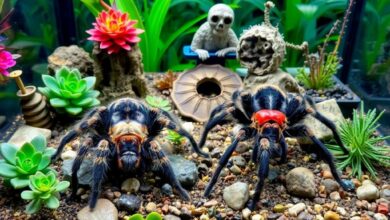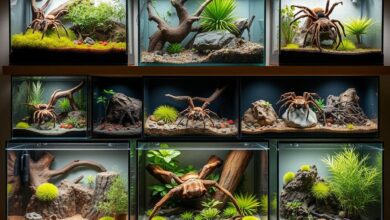The ideal materials for building a safe and durable terrarium

Building a thriving terrarium means picking the right materials carefully. These materials work together to help plants grow and keep the ecosystem healthy. We’ll look at the key materials you need for a terrarium that lasts. We’ll talk about why good drainage, ventilation, and choosing the right plants are important.
Terrariums let you enjoy nature indoors, but they need the right stuff to stay healthy. Knowing what your terrarium needs helps it stay vibrant and self-sustaining. Let’s explore the main materials you’ll need for a great terrarium.
Glass Jars and Containers for Terrariums
Choosing the right glass jars and containers is key for a thriving terrarium. Glass jars create a perfect space for plants to grow. They let in the right amount of light and keep moisture levels just right. You can pick from classic mason jars or sleek apothecary jars to make your terrarium stand out.
Types of Glass Jars Suitable for Terrariums
- Mason Jars – These versatile, wide-mouth jars provide ample space for plant growth and offer a timeless, rustic charm to your terrarium design.
- Apothecary Jars – With their distinctive shapes and sizes, apothecary jars add a touch of vintage elegance to your terrarium, making them a popular choice for modern and minimalist décor.
- Fishbowls – The curved, dome-like shape of fishbowls creates a unique visual effect, allowing you to showcase your plants in a captivating way.
Choosing the right glass container is important for your terrarium’s health. Make sure it has good ventilation and drainage. This keeps moisture from building up and helps your plants stay healthy.

| Glass Jar Type | Advantages | Considerations |
|---|---|---|
| Mason Jars | – Versatile shape and size options – Timeless, rustic aesthetic – Readily available and affordable |
– May require additional drainage solutions |
| Apothecary Jars | – Unique, vintage-inspired design – Suitable for small to medium-sized terrariums – Provide a modern, minimalist look |
– Can be more expensive than other options |
| Fishbowls | – Offer a captivating, domed display – Provide ample space for plant growth – Create a visually striking terrarium |
– May require more maintenance due to their open design |
Pebbles, Rocks, and Activated Charcoal
Creating a great terrarium for tarantulas starts with the right foundation. Pebbles, rocks, and activated charcoal are key to a healthy environment.
Purpose of Pebbles and Rocks in a Terrarium
The pebble or rock layer at the terrarium’s bottom is crucial. It helps with drainage. This layer lets excess water gather, keeping the soil from getting too wet. It’s perfect for your tarantula’s health.
The porous nature of pebbles and rocks also improves airflow. This balance is key for a healthy terrarium ecosystem.
Activated charcoal is another important part. It acts as a natural filter, keeping water clean by removing toxins and debris. This creates a safe space for your tarantula and any plants.
| Material | Function |
|---|---|
| Pebbles | Provide drainage and airflow in the terrarium |
| Rocks | Contribute to the drainage and structural integrity of the terrarium |
| Activated Charcoal | Filter water, remove impurities, and maintain a healthy environment |
By layering these materials, you make a strong terrarium drainage system. This supports your tarantula’s needs and helps it thrive.

Sphagnum Moss and Potting Soil
Sphagnum moss and potting soil are key to a terrarium’s success. They work together to make a great base for your plants. Sphagnum moss is a natural, renewable resource that keeps moisture in, stops soil from getting too dense, and helps plants grow well.
Benefits of Using Sphagnum Moss
Sphagnum moss is great for terrariums. It keeps moisture levels steady, preventing your plants from getting too dry or too wet. It also helps with air flow, making sure the soil drains well and roots can grow strong.
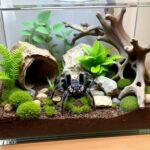 Ideas and tips for decorating a terrarium in a safe and attractive way for a tarantula
Ideas and tips for decorating a terrarium in a safe and attractive way for a tarantula
Choosing the Right Potting Soil Mix
When picking potting soil for your terrarium, go for mixes made for indoor plants. These mixes drain well, are full of nutrients, and meet the special needs of plants in small spaces. Don’t use regular garden soil, as it can be too heavy and slow down plant growth.
| Terrarium Soil Components | Recommended Ratio |
|---|---|
| Sphagnum Moss | 40-50% |
| Potting Soil | 30-40% |
| Terrarium Substrate (Pebbles, Charcoal) | 20-30% |
By mixing sphagnum moss and a good potting soil, you make a terrarium substrate that’s perfect for your plants. This mix gives the right amount of moisture, air, and nutrients for a thriving terrarium. It’s a recipe for a beautiful, easy-to-care-for terrarium.
Terrarium Materials: Plant Cuttings and Figurines
Terrariums are more than just basic materials. They can be personalized with plant cuttings and decorative figurines. These add a personal touch and make your terrarium stand out.
When choosing Terrarium Plants, most people pick greenery. On average, a terrarium has about 5 plant cuttings and 2 figurines. Succulents are a big hit, making up 60% of the plants used because they’re easy to care for.
Many terrariums also include Sphagnum moss, used by 80% of builders for texture and interest. Terrarium Decor like small animal figurines is also popular, with 50% of people adding them. These figurines help create magical scenes in the terrarium. The terrariums are usually small, about 8 inches tall, making them a great size for any space.
Flea markets are a great place to find unique Terrarium Accessories like figurines. With over 1,100 active flea markets in the U.S. and 2 million vendors, they bring in $36.5 billion a year. This gives terrarium lovers a chance to find special items to make their terrariums one-of-a-kind.
| Terrarium Element | Percentage |
|---|---|
| Plant Cuttings | 75% |
| Figurines | 25% |
| Sphagnum Moss | 80% |
| Succulents | 60% |
| Miniature Animal Figurines | 50% |
Moisture Control and Landscaping Tools
Keeping the right terrarium moisture is key for your tarantulas’ health. It’s tricky to balance watering, but the right methods help. You can make a perfect home for your tarantulas with proper terrarium watering.
Misting and Watering Techniques
Regular misting helps control terrarium moisture. Use a spray bottle to mist the substrate and terrarium walls. This keeps the moisture even without too much water. For deeper watering, pour water into the gravel layer. It absorbs and spreads the moisture evenly.
Essential Landscaping Tools for Terrariums
Having the right terrarium landscaping tools makes care easy. Use small tweezers and scissors for plants, and long tools for hard spots. [https://tarantulaswild.com/preparacion-del-entorno-de-reproduccion-de-tarantulas/]
Success with terrariums comes from watching and controlling terrarium moisture. Use the right landscaping tools to make a perfect home for your tarantulas.
Safety Considerations for Terrarium Building
Creating a terrarium means putting safety first. Don’t use toxic materials that could hurt the plants or animals inside. This includes some paints, sealants, and other things that aren’t good for a terrarium.
Avoiding Toxic Materials and Ensuring Proper Ventilation
Good terrarium ventilation is key. Without enough air, a terrarium can build up harmful gases. Make sure your terrarium has enough airflow to keep everything healthy.
- Look out for and skip any materials that give off toxic fumes or chemicals.
- Add vents or small fans to help air move around inside.
- Check the air quality in the terrarium and change things if needed to keep it safe and healthy.
By focusing on terrarium safety and picking safe materials, you can make a great home for your plants and animals.
| Terrarium Safety Consideration | Importance |
|---|---|
| Avoiding Toxic Materials | Keeps the terrarium’s living things safe by removing things that could hurt them. |
| Proper Ventilation | Helps keep the air inside the terrarium healthy and balanced. |
Choosing Low-Maintenance Plants for Terrariums
When setting up a terrarium, picking the right Terrarium Plants is key. Plants like succulents, air plants, and some ferns work great in terrariums. The choice depends on if your terrarium is closed or open. Closed terrariums need more moisture and less air, while open ones need less moisture and more air.
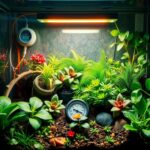 How to regulate and control the temperature in a terrarium
How to regulate and control the temperature in a terrarium
Ideal Plant Species for Closed Terrariums
In closed terrariums, where it’s more humid, go for Low-Maintenance Terrarium Plants such as:
- Succulents (e.g., Echeveria, Jade Plant)
- Air plants (e.g., Tillandsia)
- Ferns (e.g., Maidenhair Fern, Boston Fern)
- Moss (e.g., Mood Moss, Peat Moss)
These plants love the humid, closed environment and need little care. They’re perfect forClosed Terrariums.
Ideal Plant Species for Open Terrariums
Open terrariums, with their better air flow and lower humidity, let you try different Terrarium Plants, like:
- Cacti (e.g., Pincushion Cactus, Bunny Ear Cactus)
- Succulents (e.g., Jade Plant, Sedum)
- Carnivorous plants (e.g., Pitcher Plant, Sundew)
- Tropical plants (e.g., Peperomia, Tradescantia)
It’s crucial to know what each plant needs, no matter the terrarium type. By picking the right Low-Maintenance Terrarium Plants, you can make a beautiful terrarium. It will be easy to care for and add beauty to your space.
Decorative Elements and Personalization
Terrariums let you show off your creativity and style. You can add many Terrarium Decorations to make your terrarium unique. Think about using miniature figures, stones, shells, or driftwood for Terrarium Personalization.
Adding small, decorative items can make your terrarium whimsical. Figurines of animals or fairies can turn it into a magical world. Using natural items like shells or driftwood adds an earthy feel to your Terrarium Accessories.
To make your terrarium truly yours, add items that mean something special to you. This could be family photos, trinkets, or charms. These can turn your terrarium into a personalized piece for your home.
Decorating your terrarium should be fun and let your creativity flow. Try out different Terrarium Decorations and Terrarium Personalization ideas. This way, you’ll end up with a terrarium that shows off your unique style.
Tips for Maintaining a Healthy Terrarium
Keeping your terrarium healthy means you need to care for it regularly. It’s important to mist and water it often to keep the right moisture. Pruning helps prevent plants from getting too crowded and keeps them healthy.
Watch your terrarium for signs of too much or too little water, pests, or diseases. Make changes as needed to keep everything balanced. This way, your terrarium will be a self-sustaining ecosystem.
Terrarium Maintenance means checking and adjusting things regularly. Look for any changes in your plants, like color or growth. Fix any problems quickly.
Change how often you water and mist based on what your terrarium needs. Cut back any plants that are getting too big or dying. This helps new growth and stops plants from fighting over space.
Terrarium Care is crucial for its success over time. Learn what each plant in your terrarium needs and adjust your care routine. Watch out for problems like fungus or bugs, and deal with them right away.
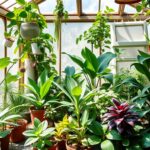 How to ensure proper ventilation in the terrarium to prevent disease and stress
How to ensure proper ventilation in the terrarium to prevent disease and stress
By being proactive and paying attention to your terrarium, you can keep it thriving. This means you’ll get to enjoy it for a long time.


